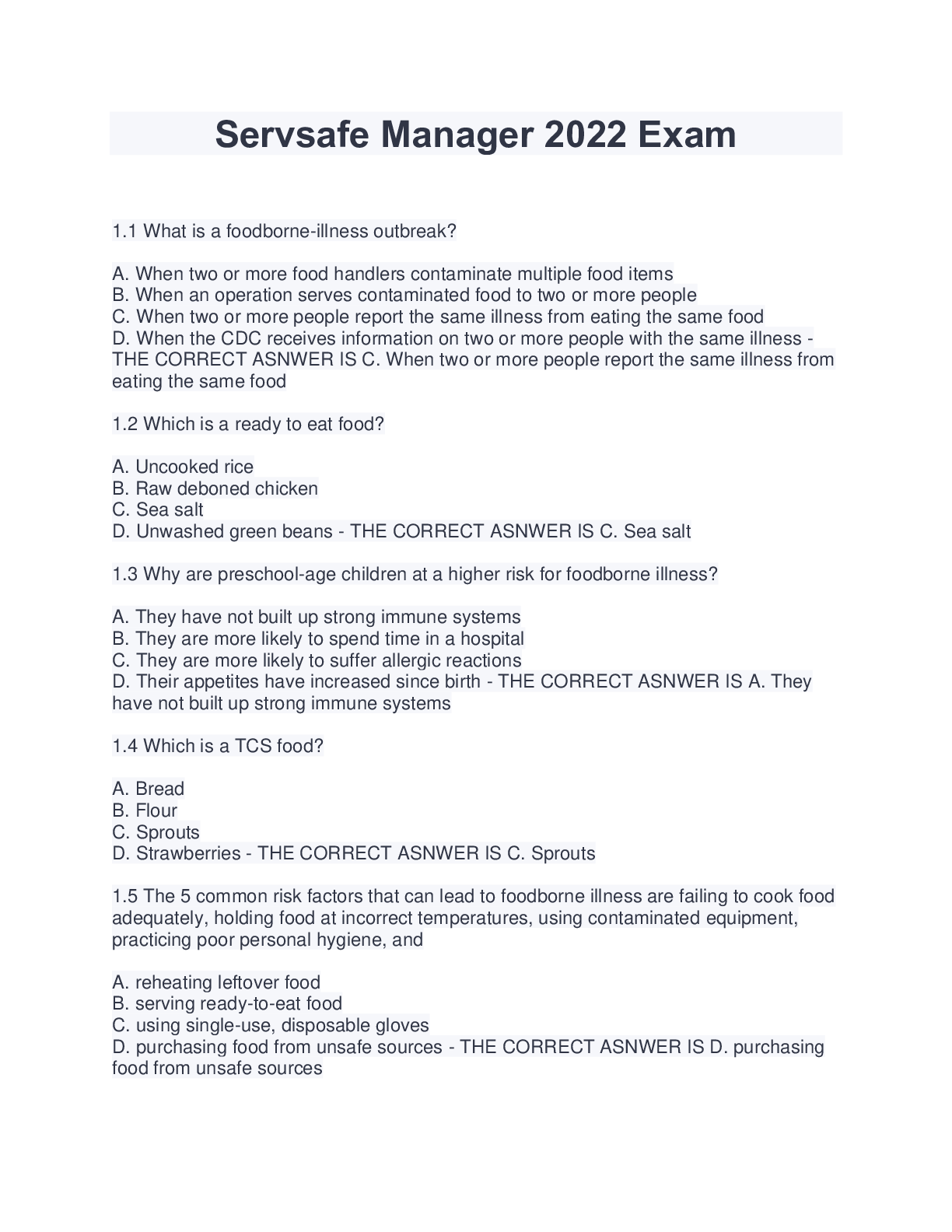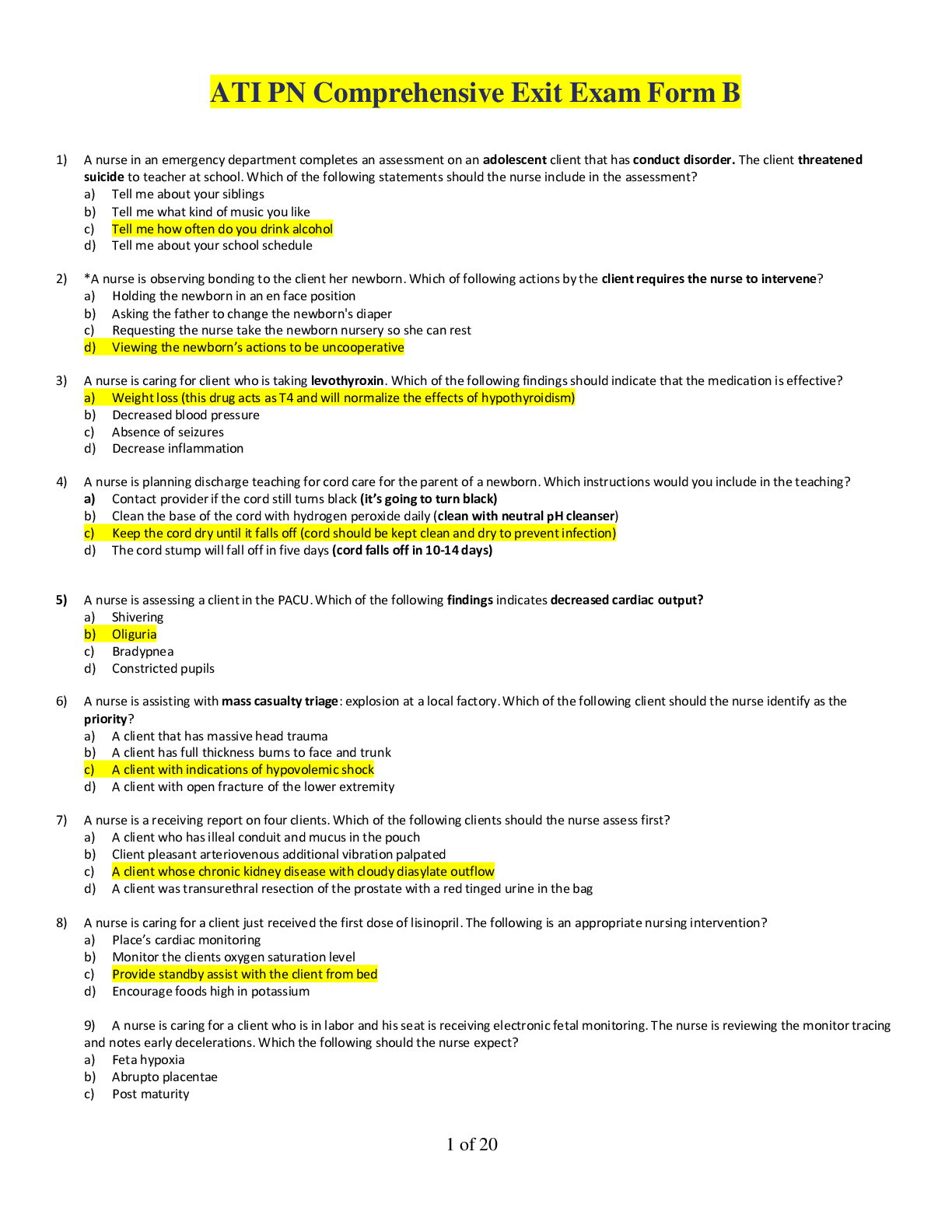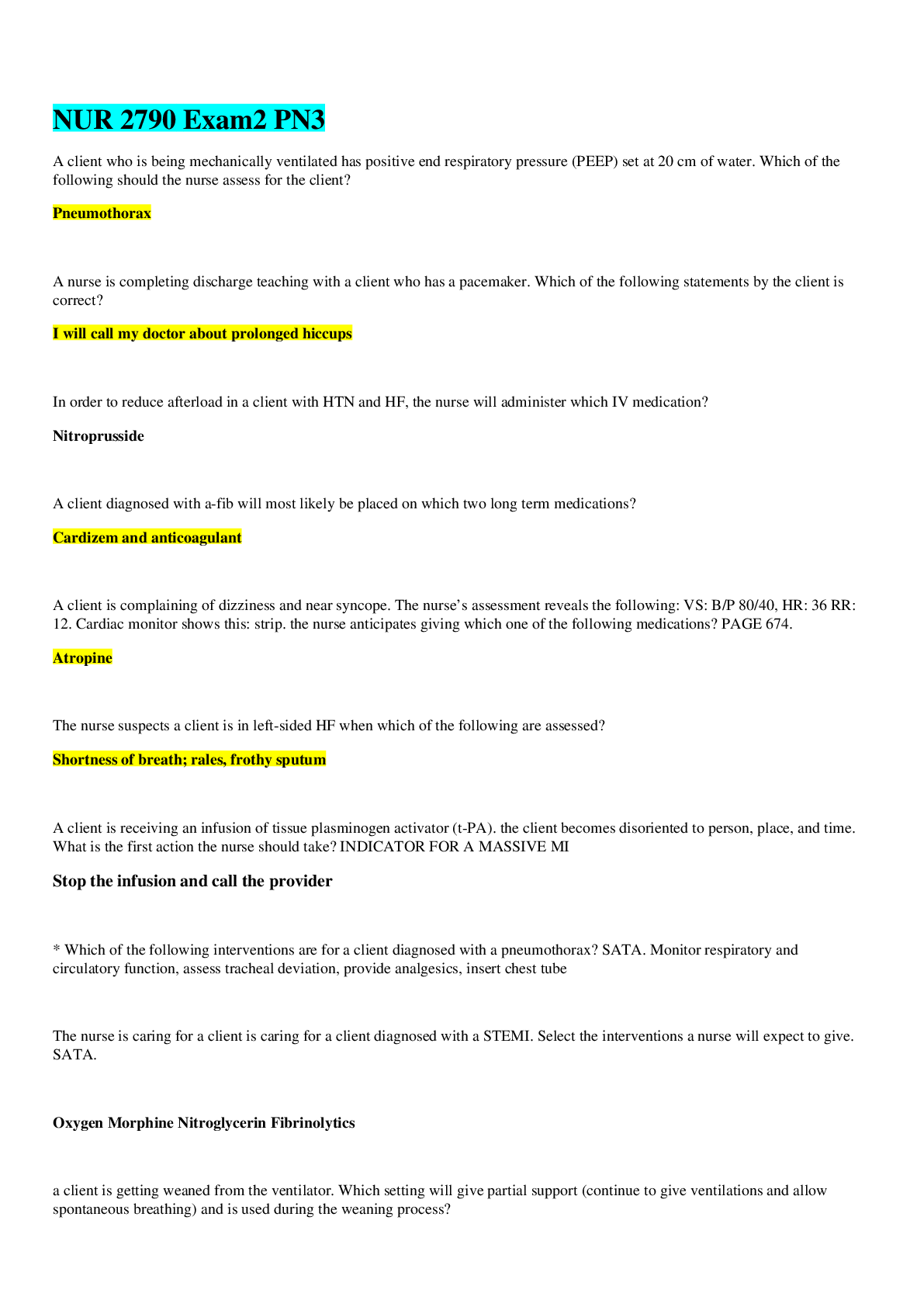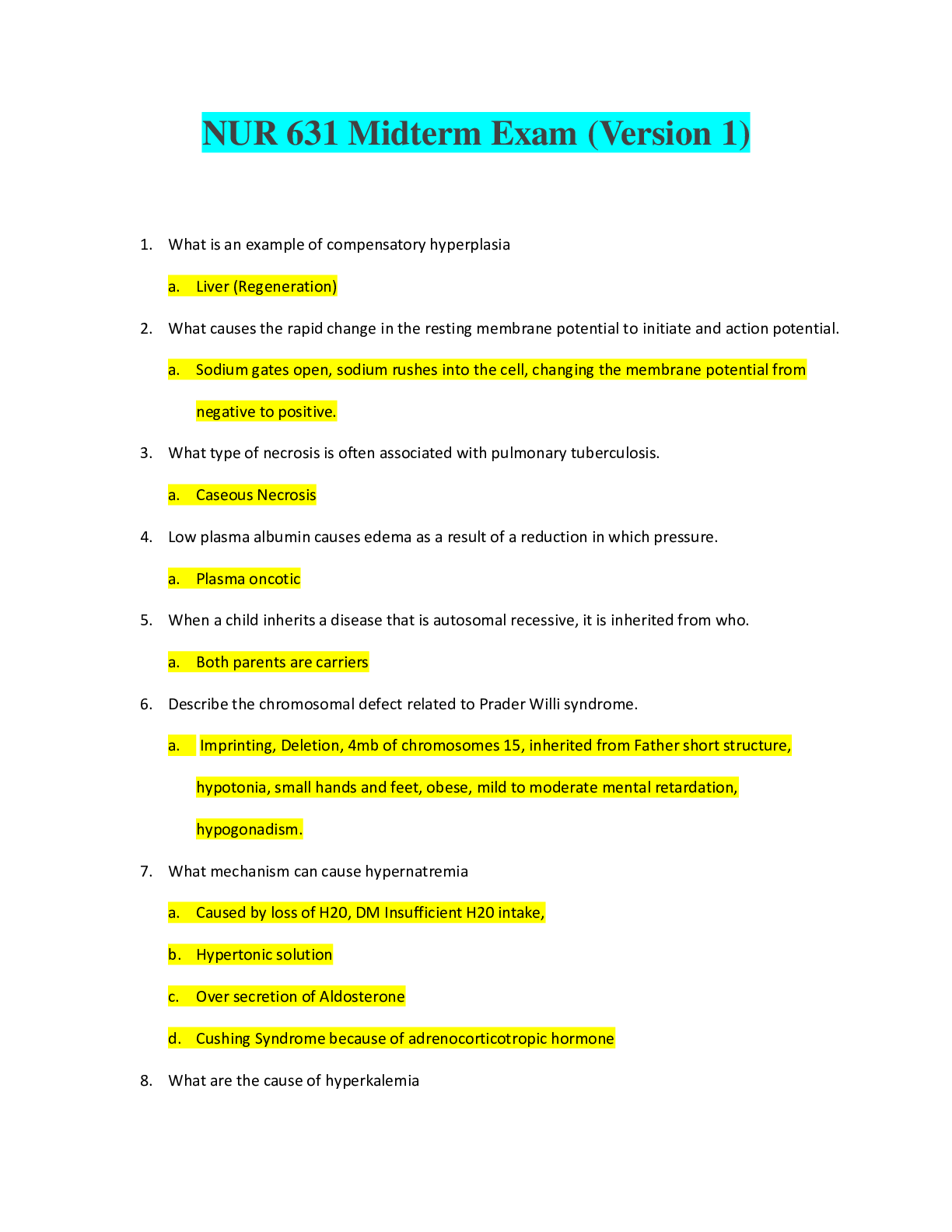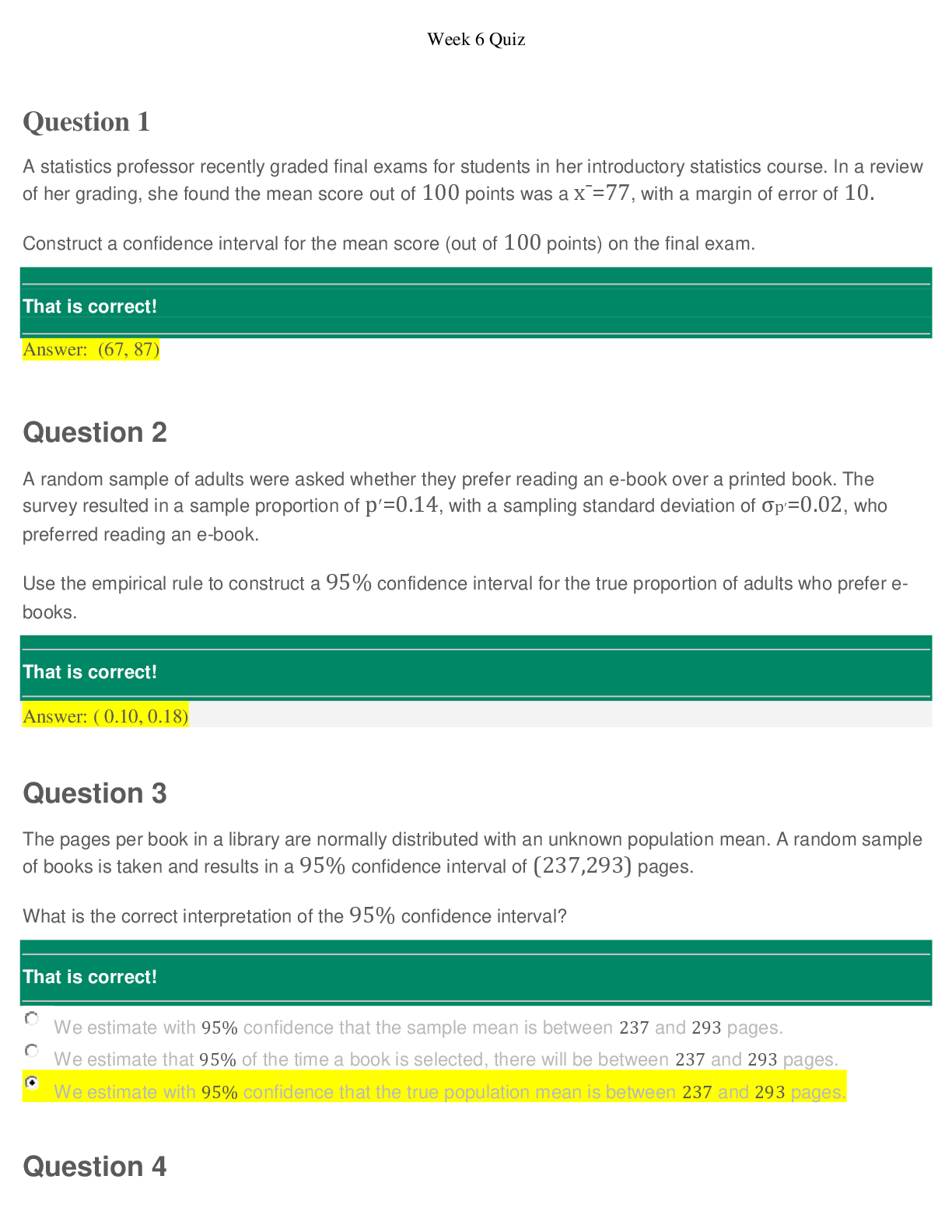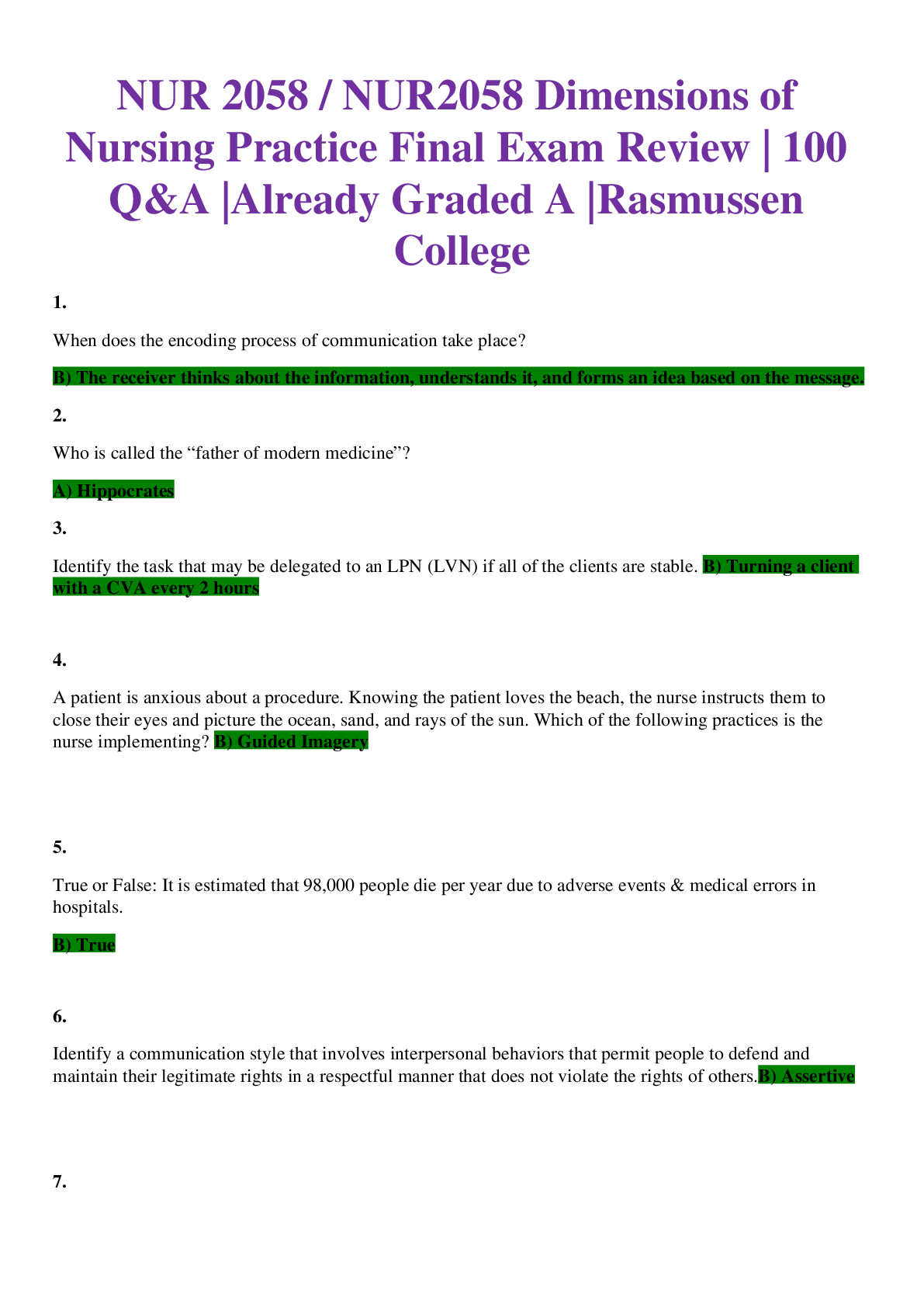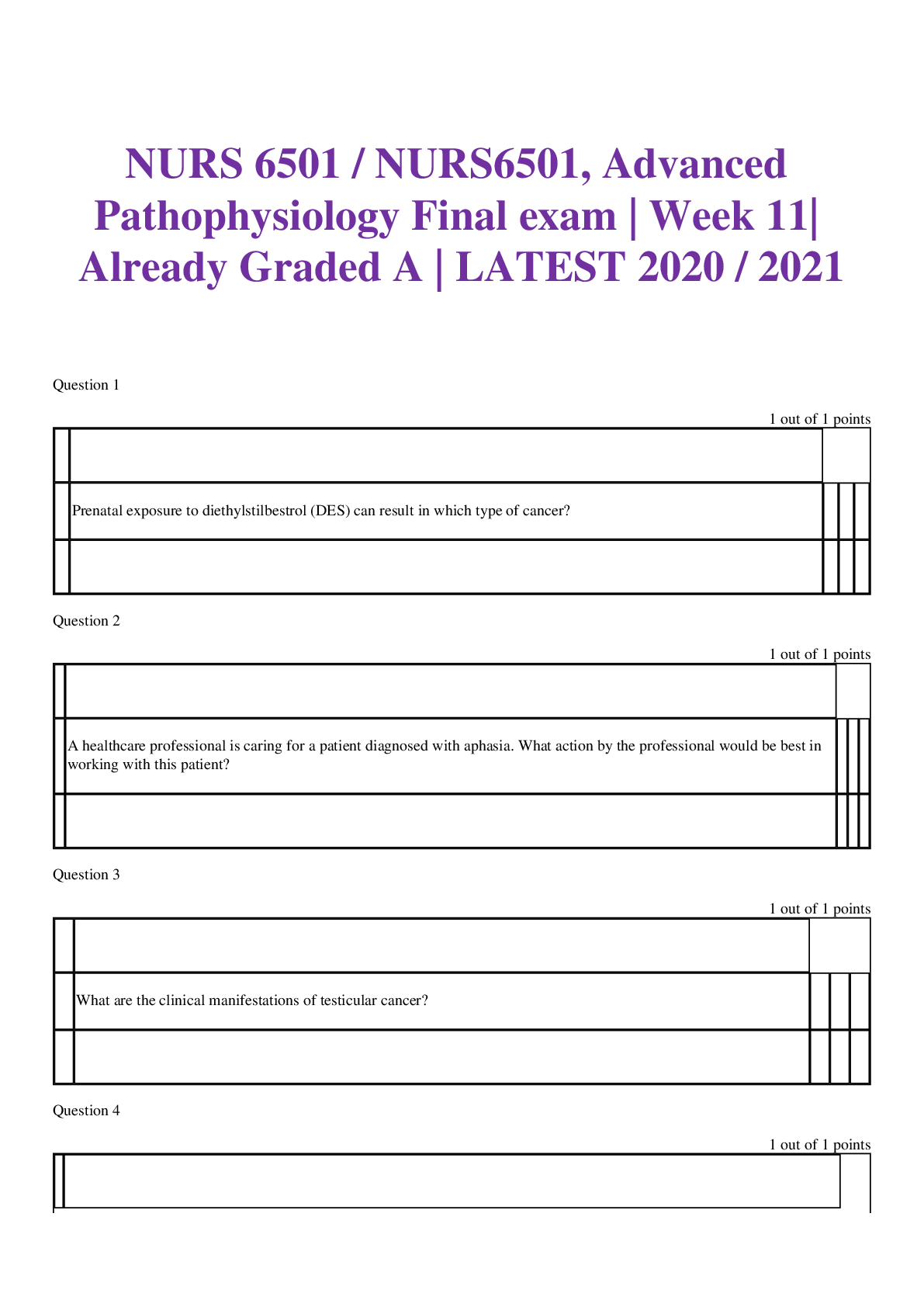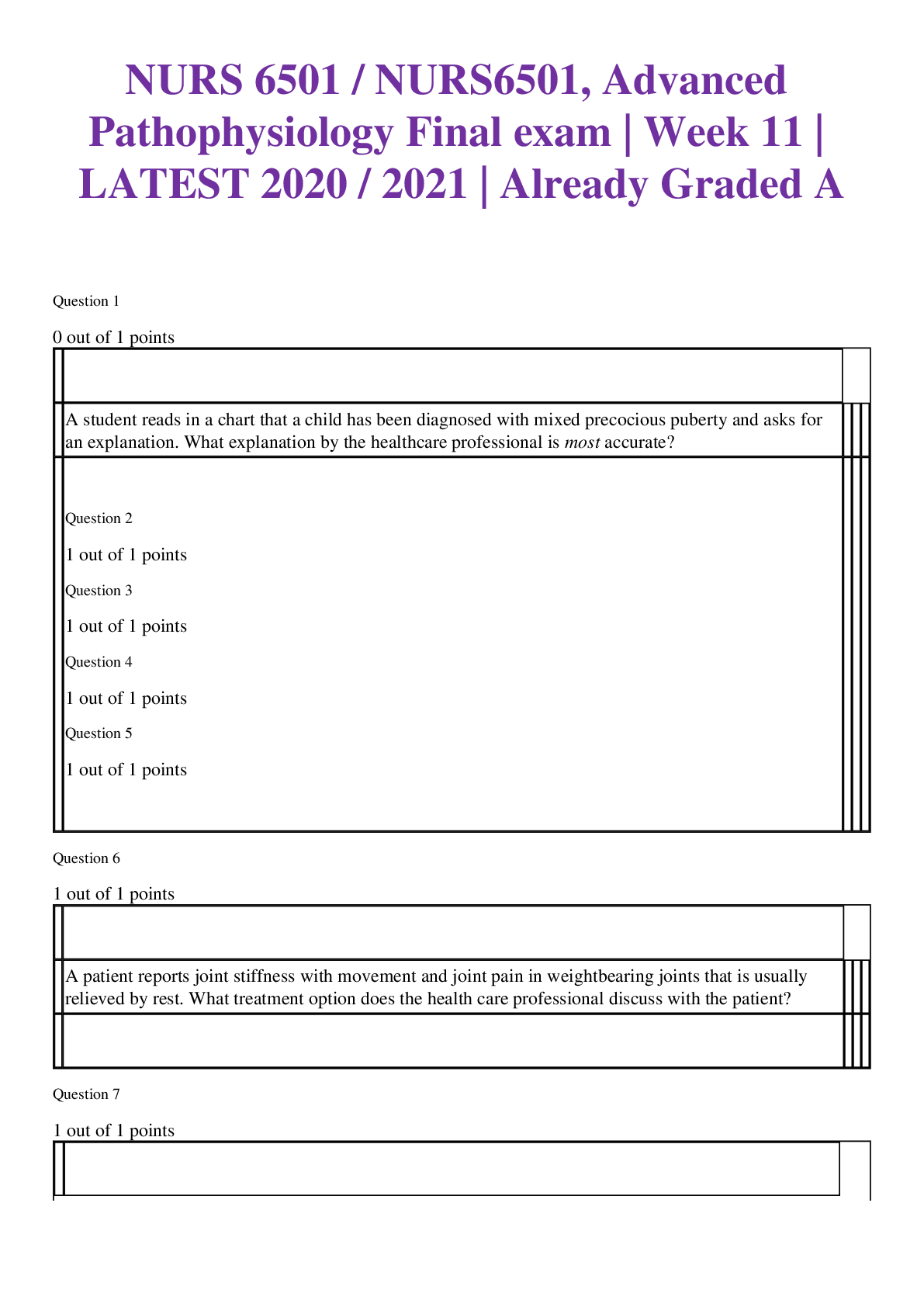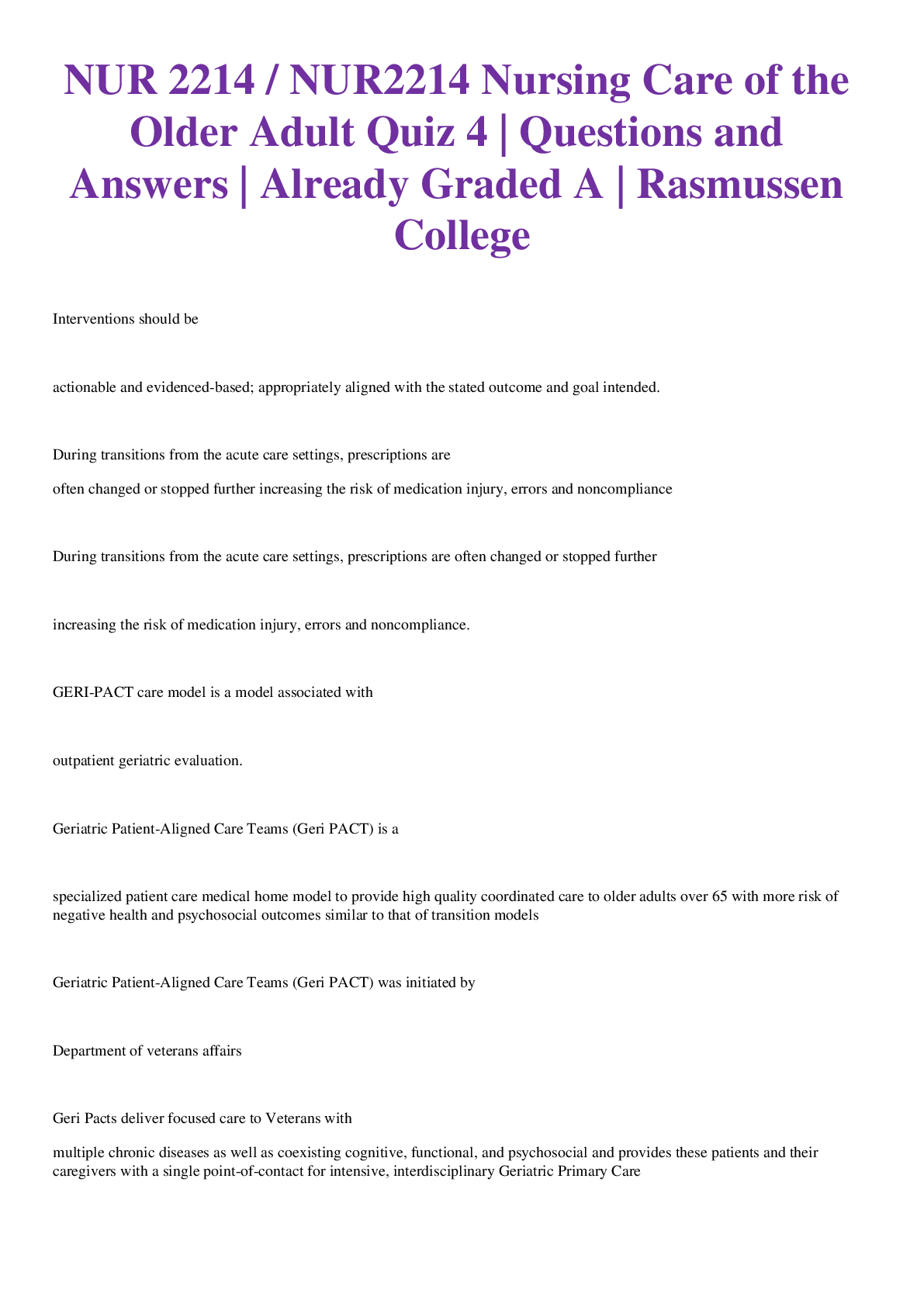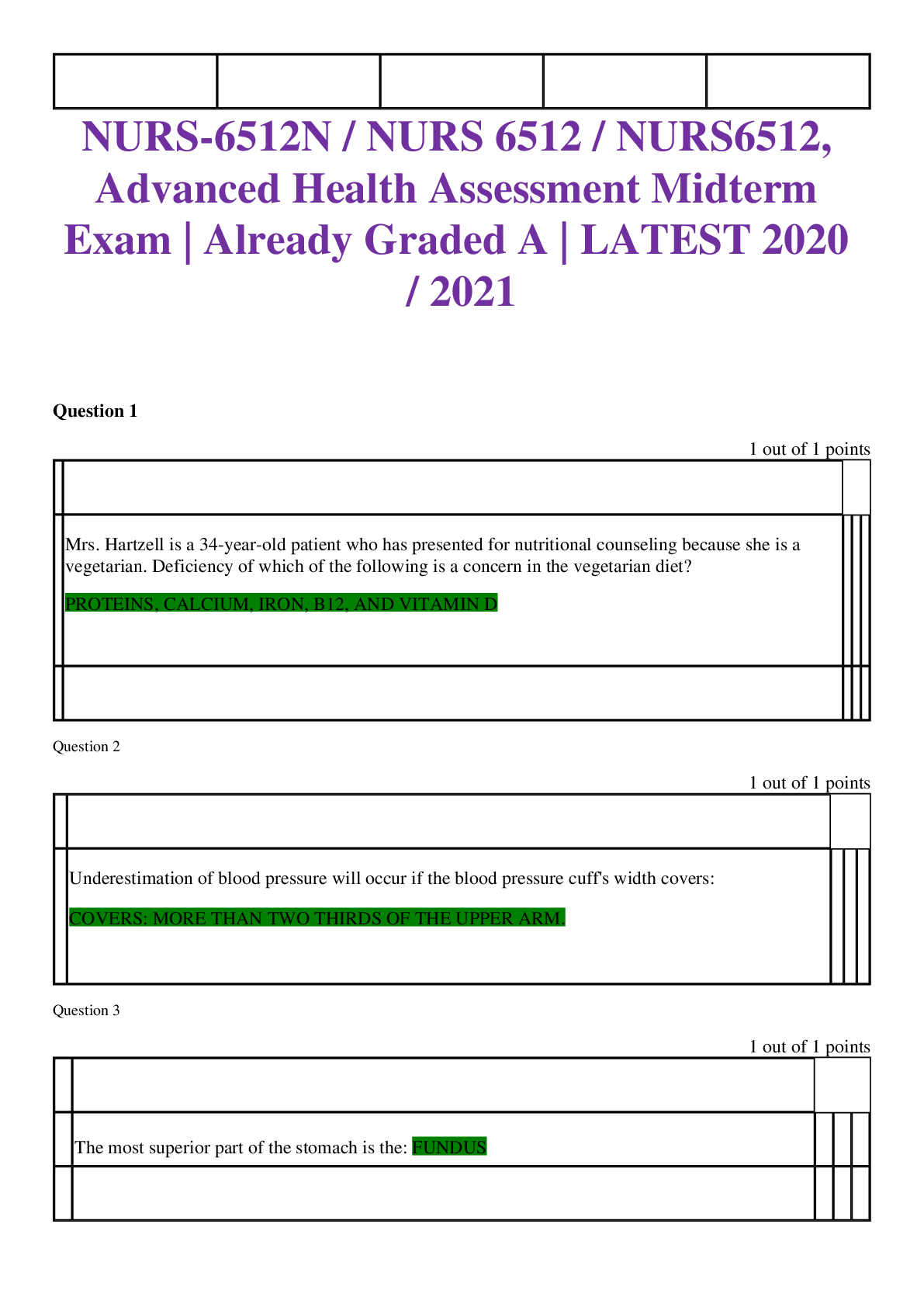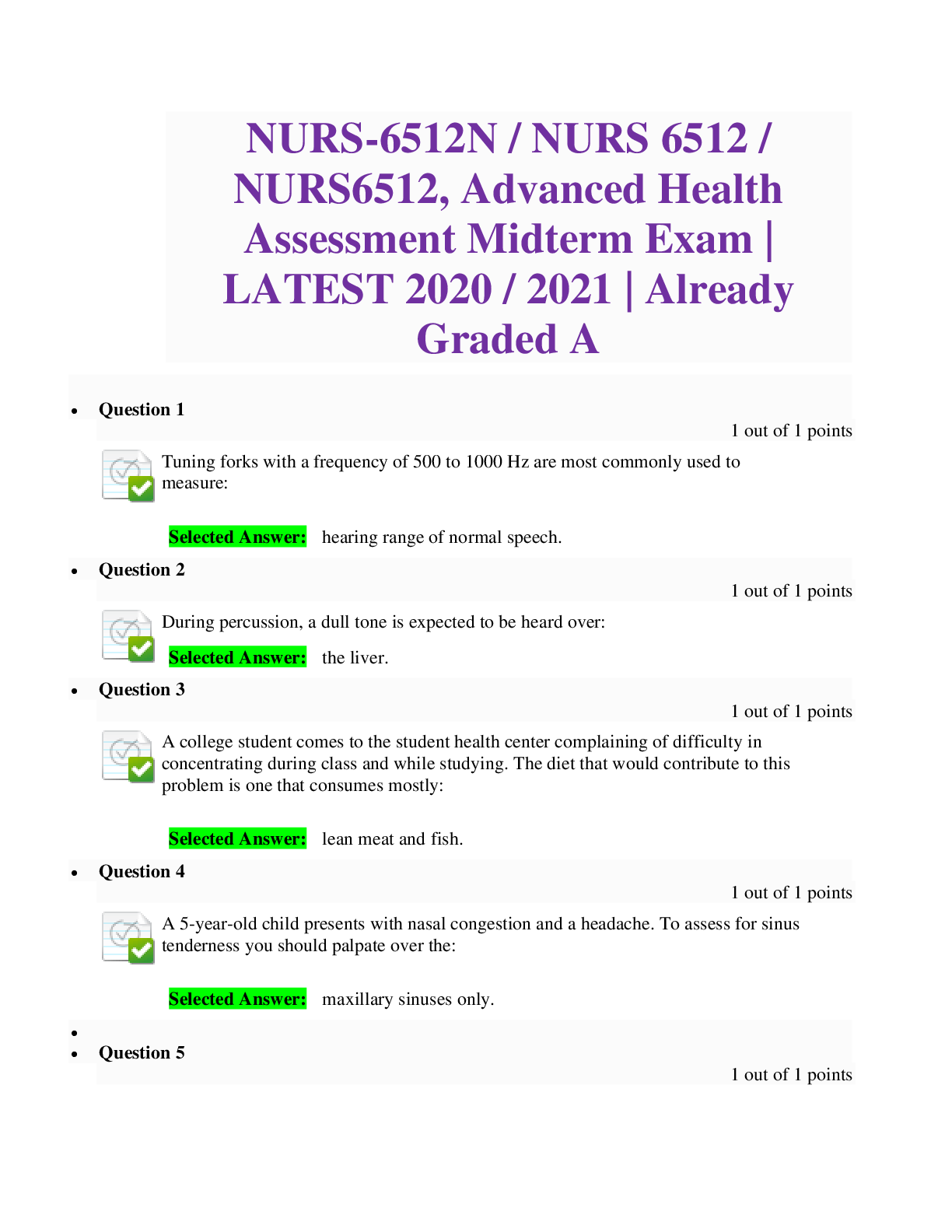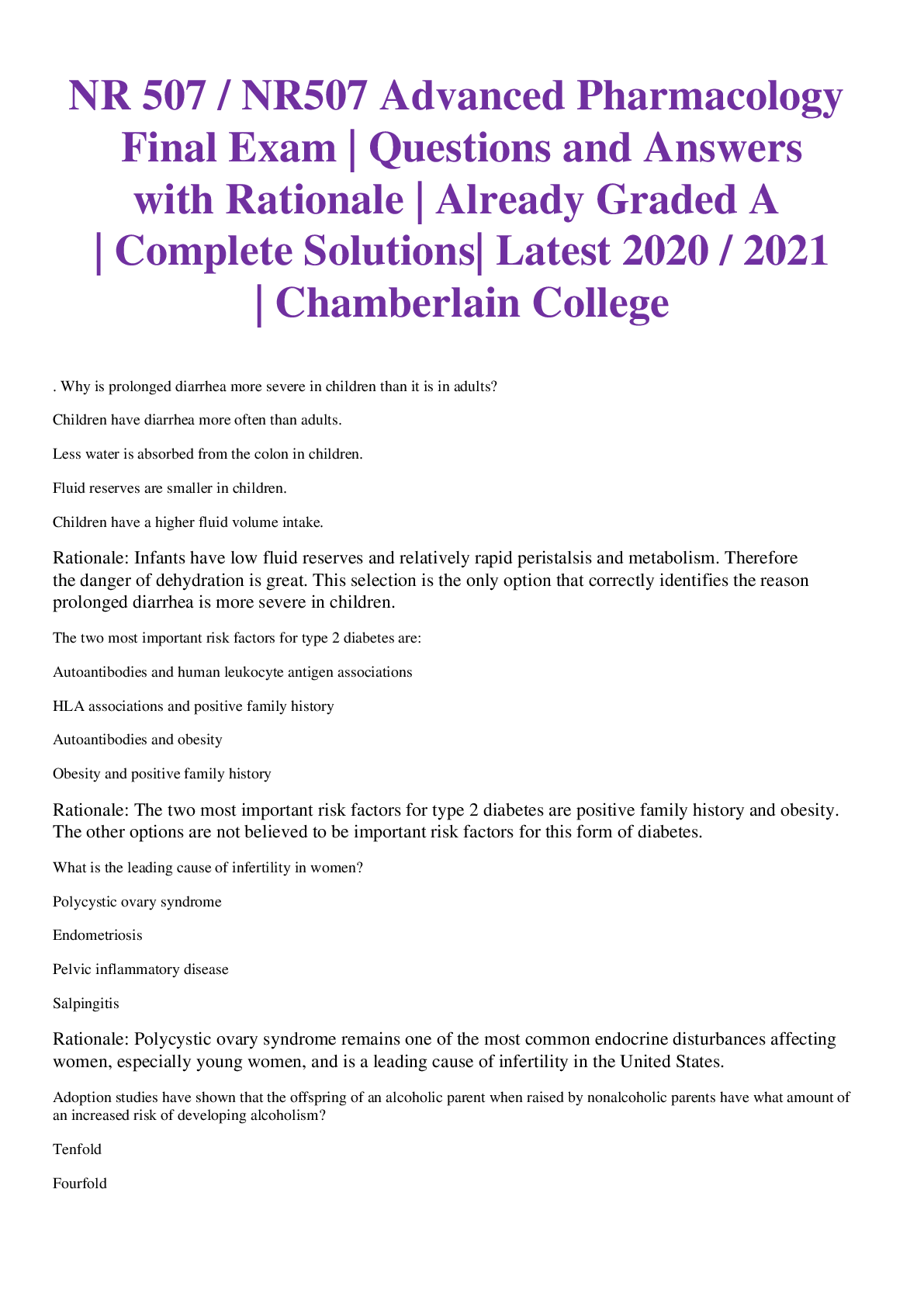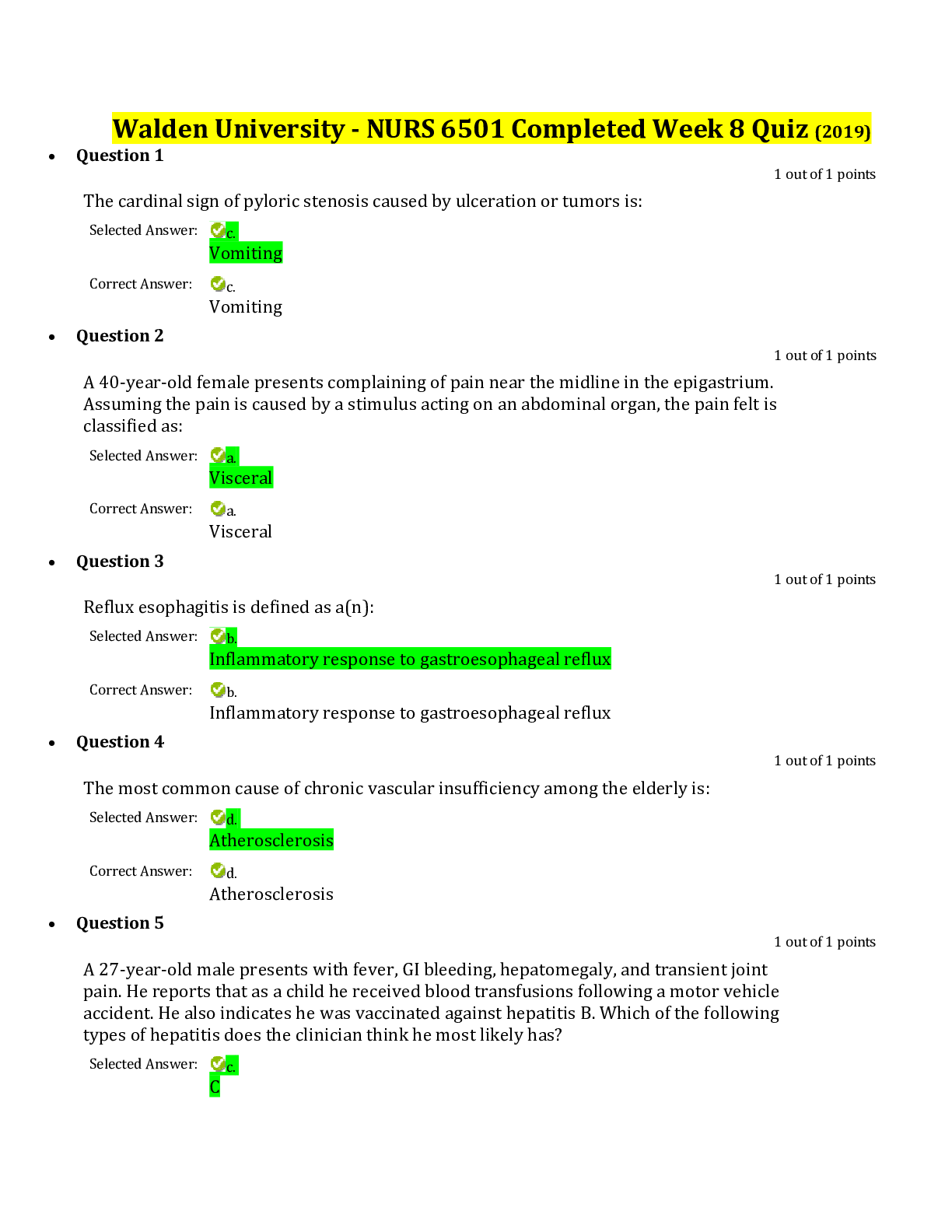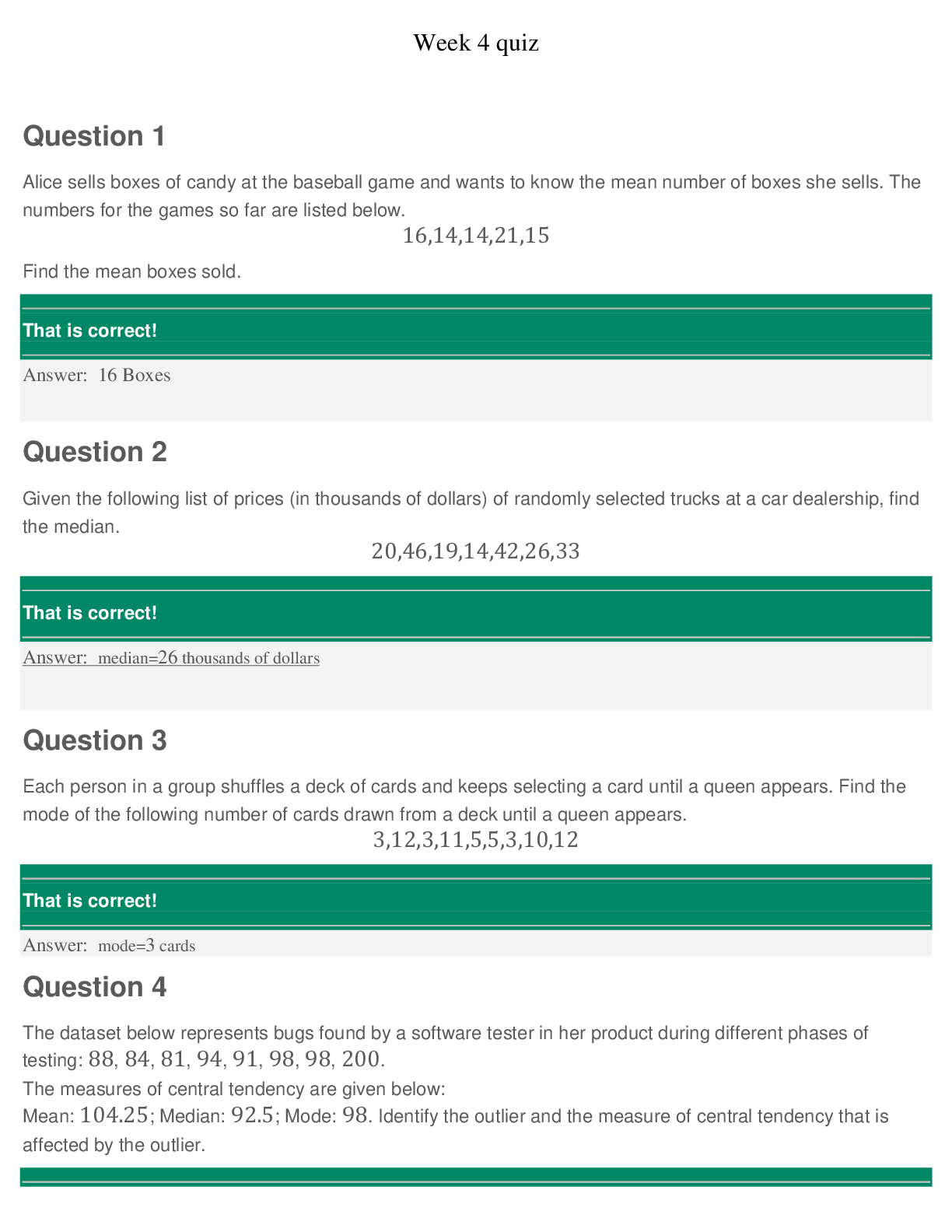*NURSING > EXAM > CONTEMPORARY MATERNAL NEWBORN NURSING 9TH EDITION BY LADEWIG.WITH ANSWERS AND EXPLANATIONS ALREADY G (All)
CONTEMPORARY MATERNAL NEWBORN NURSING 9TH EDITION BY LADEWIG.WITH ANSWERS AND EXPLANATIONS ALREADY GRADED A
Document Content and Description Below
Contemporary Maternal-Newborn Nursing, 9e (Ladewig et al.) Chapter 2 Family, Culture, and Complementary Health Approaches 1) While conducting a family assessment, the nurse determines that a partic... ular family's structure is binuclear. Some potential challenges inherently faced by binuclear families include: 2) The nurse is preparing a community presentation on family development. Which of the following statements should the nurse include? 3) The nurse is preparing to assess the development of a family new to the clinic. The nurse understands that the primary use of a family assessment tool is to: 4) A nurse is caring for a Muslim client who is pregnant. She is anticipating delivery within the next few days. The nurse asks if she and her husband have chosen a name for their baby. The patient quietly shakes her head, "no." Based upon the patient's response, the nurse understands that: 5) A woman of Korean descent has just given birth to a son. Her partner wishes to give her sips of hot broth from a thermos that he brought from home. The client has refused your offer of ice chips or other cold drinks. The nurse should: 6) The nurse works in a facility that cares for clients from a broad range of racial, ethnic, cultural, and religious backgrounds. Which statement should the nurse include in a presentation for nurses new to the facility on the client population of the facility? 7) The nurse manager in a hospital with a large immigrant population is planning an in-service. The nurse manager is aware of how ethnocentrism affects nursing care. Which statement should the nurse manager include? "The belief that ones own values and beliefs are the only or the best values: 8) When preparing to teach a culturally diverse group of childbearing families about hospital birthing options, in order to be culturally competent, the nurse should: 9) A nurse is admitting a Mexican woman scheduled for a cholecystectomy. The nurse uses a cultural assessment tool during the admission. Which question would be most important for the nurse to ask? 10) The labor and delivery nurse is caring for a laboring client who has asked for a priest to visit her during labor. The client's mother died during childbirth, and although there are no complications during the client's pregnancy, she is fearful of her own death during labor. What is the best response of the nurse? 11) A pregnant client reports experiencing occasional gastroesophageal reflux. She explains that she relieves her symptoms through acupressure treatments, as well as by taking an over-the- counter medication recommended by her obstetrician. The nurse recognizes acupressure to be a form of: 1. Homeopathy. 2. Alternative therapy. 3. Biofeedback. 4. Complementary therapy. Answer: 4 Explanation: 1. Homeopathy entails using diluted amounts of substances that, if ingested in larger amounts, would produce effects similar to the symptoms of the disorder being treated. 2. Alternative therapy involves the use of a procedure or substance in place of conventional medicine. 3. Biofeedback control pertains to using the mind to control physiologic responses based on the concept that the mind controls the body. 4. Complementary therapy incorporates the use of a procedure or product as an adjunct to conventional medical treatment. Page Ref: 17, 18 Cognitive Level: Comprehension Client Need&Sub: Physiological Integrity Standards: QSEN Competencies: Patient-centered care | AACN Essential Competencies: Essential IX: Baccalaureate generalist nursing practice | NLN Competencies: Human flourishing | Nursing/Integrated Concepts: Nursing Process: Evaluation/Coordination of care Learning Outcome: LO 2.8-DistinguishNbUetRwSeINenGTcBo.mCOplMementary and alternative therapies. MNL LO: Recognize common discomforts of pregnancy and measures that can provide relief. 12) A client reports using "homeopathic remedies" to ease her back pain. In order to more fully explore the client's use of complementary and alternative medicine (CAM), the nurse should ask: 1. "Will you tell me more about the homeopathic remedies you're using?" 2. "Are you aware that some complementary and alternative therapies can be dangerous?" 3. "Does your physician approve of your use of homeopathic remedies?" 4. "Have you prioritized your need for comfort above your concern for your baby's health?" Answer: 1 Explanation: 1. The nurse should ask direct, nonjudgmental questions when seeking to gain information about a patient's use of CAM. 2. While tactful warnings regarding the use of CAM may be appropriate, the nurse should first explore the patient's use of CAM in a nonjudgmental manner. 3. Clients may be reluctant to discuss their use of CAM with their healthcare providers; the nurse should explore the topic using nonjudgmental language. 4. Additional information is needed in order to evaluate the client's use of CAM, and the topic should be approached without use of disparaging comments. Page Ref: 18 Cognitive Level: Application Client Need&Sub: Physiological Integrity | Basic Care and Comfort Standards: QSEN Competencies: Patient-centered care | AACN Essential Competencies: Essential II: Basic organizational and systems leadership for quality care and patient safety | NLN Competencies: Human flourishing | Nursing/Integrated Concepts: Nursing Process: Planning/Coordination of care Learning Outcome: LO 2.8-Distinguish between complementary and alternative therapies. MNL LO: Recognize common discomfoNrUtsRoSfINpGreTgBn.CanOcMy and measures that can provide relief. 13) The client pregnant with her first child reports that her husband wants her to visit a homeopath for help with her nausea and vomiting. The client asks what the nurse's opinion of homeopathy is. The best response by the nurse is: 1. "Homeopathy is unproven and potentially dangerous. Avoid using homeopathic remedies." 2. "The FDA has approved homeopathic remedies, and practitioners undergo education and certification." 3. "I cant give you advice about what alternatives to try. Go online and do some research to get information." 4. "Homeopathy is the same as herbal remedies. Some are safe during pregnancy and some are not." Answer: 2 Explanation: 1. Homeopathic remedies are not dangerous. Homeopathic remedies are FDA- approved and have been proven to be effective in treating a wide range of chronic and acute illnesses and conditions. 2. Homeopathic remedies are FDA-approved and have been proven to be effective in treating a wide range of chronic and acute illnesses and conditions. 3. It is appropriate for the nurse to provide factual information to educate a client who has asked a question. Not all clients have access to computers, nor do they know how to do an internet search. 4. Herbalism and homeopathy are not the same. Herbs are available in many stores and preparations; some have been proven to be dangerous during pregnancy. Homeopathy is a system of "like curing like," in which the symptom being treated would be a symptom of taking too much of the substance in a non-homeopathic form. Page Ref: 18 Cognitive Level: Analyzing Client Need&Sub: Health Promotion and Maintenance Standards: QSEN Competencies: Patient-centered care | AACN Essential Competencies: Essential II: Basic organizational and systems leadership for quality care and patient safety | NLN Competencies: Human flourishing | Nursing/Integrated Concepts: Nursing Process: Implementation/Coordination of care Learning Outcome: LO 2.9-Describe the benefits and risks of the various complementary and alternative therapies to the childbearing family. MNL LO: Recognize common discomforts of pregnancy and measures that can provide relief. 14) Complementary and alternative therapies have many benefits for the childbearing family and others. However, many of these remedies have associated risks. Which of the following situations would be considered risks? Select all that apply. 1. Getting a massage from a licensed massage therapist for back pain, prescribed by the primary caregiver 2. Sampling a homeopathic medicine from a friend to reduce swelling in the legs 3. Getting a chiropractic treatment for low back pain due to discomforts of pregnancy without telling the primary health care provider 4. Taking an herbal preparation suggested by a health food store worker for treatment of leg pain 5. Joining a group that practices tai chi weekly to help with physical fitness and movement Answer: 2, 3, 4 Explanation: 1. Getting a massage from a licensed massage therapist for back pain, prescribed by the primary caregiver, is a perfectly good use of complementary therapies. 2. Trying out a homeopathic medicine from a friend to reduce swelling in your legs is a risk factor when considering these therapies. Lack of standardization, lack of regulation and research to substantiate their safety and effectiveness, and inadequate training and certification of some healers make some therapies risky. 3. Getting a chiropractic treatment for low back pain due to discomforts of pregnancy without telling the primary health care provider is a risk factor when considering these therapies. Lack of standardization, lack of regulation and research to substantiate their safety and effectiveness, and inadequate training and certification of some healers make some therapies risky. 4. Taking an herbal preparation suggested by a health food store worker for treatment of leg pain is a risk factor when considering these therapies. Lack of standardization, lack of regulation and research to substantiate their safety and eNfUfeRcStiIvNeGnTeBss.C, OanMd inadequate training and certification of some healers make some therapies risky. 5. Joining a group that practices tai chi weekly to help with physical fitness and movement is a perfectly good use of complementary therapies. Page Ref: 18 Cognitive Level: Application Client Need&Sub: Safe and Effective Care Environment | Management of Care Standards: QSEN Competencies: Patient-centered care | AACN Essential Competencies: Essential II: Basic organizational and systems leadership for quality care and patient safety | NLN Competencies: Human flourishing | Nursing/Integrated Concepts: Nursing Process: Evaluation/Coordination of care Learning Outcome: LO 2.9-Describe the benefits and risks of the various complementary and alternative therapies to the childbearing family. MNL LO: Recognize common discomforts of pregnancy and measures that can provide relief. 15) The labor and delivery unit nurse manager is incorporating complementary and alternative therapies into the units policies and procedures. Which statement should the nurse manager include during an in-service educational presentation for the nursing staff? 1. "Policies have been developed for using massage and aromatherapy." 2. "When clients ask questions you don't know, tell them to look online." 3. "Because herbs are dangerous during pregnancy, we will not use them." 4. "Be sure to ask clients what alternative therapies they have used." Answer: 1 Explanation: 1. The development of written policies and procedures facilitates safe nursing practice, which in turn promotes client safety. 2. Online information can vary in its accuracy. Reputable sources (electronic or print) should be recommended for further client education. 3. This statement is false. Many herbs can be safely used during pregnancy. 4. What the client has used in the past does not predict what she is open to using at present. It is more important to develop written policies and procedures. Page Ref: 19, 20 Cognitive Level: Application Client Need&Sub: Physiological Integrity | Basic Care and Comfort Standards: QSEN Competencies: Patient-centered care | AACN Essential Competencies: Essential V: Healthcare policy, finance, and regulatory environments | NLN Competencies: Professional identity | Nursing/Integrated Concepts: Nursing Process: Planning/Coordination of care Learning Outcome: LO 2.10-Formulate nursing care within the nurse practice act and with the informed consent of the client when usinNgUaRpSpIrNoGpTriBa.tCeOcMomplementary therapies with childbearing families. MNL LO: Recognize common discomforts of pregnancy and measures that can provide relief. 16) A nurse is discussing the 8 stages of the family cycle with the parents of a 12-year-old child. Which stages should the nurse discuss first? Select all that apply. 1. Readjustment of the marital relationship, parent/child establishment of separate identities outside of family 2. Facilitating peer relationships while maintaining family dynamics 3. Marriage between partners, identification as part of family, establishment of goals for future, interaction and building relationship 4. Increase in child's independence, parents concentrate on shift to aging parent careers and marital relationship 5. Established family network, socialization of child, reinforce independence in child when apart from parents Answer: 2, 4 Explanation: 1. The nurse would explain the stage the family is in and the next stage the family will be going into. 2. The nurse would explain the stage the family is in and the next stage the family will be going into. 3. The nurse would explain the stage the family is in and the next stage the family will be going into. 4. The nurse would explain the stage the family is in and the next stage the family will be going into. 5. The nurse would explain the stage the family is in and the next stage the family will be going into. Page Ref: 14 Cognitive Level: Application Client Need&Sub: Physiological Integrity | Basic Care and Comfort Standards: QSEN Competencies: Patient-centered care | AACN Essential Competencies: Essential IX: Baccalaureate generalist nursing practice | NLN Competencies: Human flourishing | Nursing/Integrated Concepts: Nursing Process: Implementation/Coordination of care Learning Outcome: LO 2.10-Formulate nursing care within the nurse practice act and with the informed consent of the client when using appropriate complementary therapies with childbearing families. MNL LO: Relate the effect of culture and family to the childbearing experience. 17) The nurse is discussing culture with the Japanese family and practices to which they subscribe. Which examples clearly define acculturation? Select all that apply. 1. A first generation Italian lives in an Italian community in the United States and follows Italian traditions and values, continues to speak Italian. 2. A 65-year-old was born and raised in Pennsylvania, moved to Georgia at the age of 40, has a change in pronunciation and customs. 3. A Native American from the reservation goes to Phoenix to live and go to school. The Native American goes home on the weekends to help the family with chores, when sick goes home for traditional healing. 4. The granddaughter of a Chinese immigrant has lived in the United States all of her life including college. She spends most of her time with American friends, dresses as they do and appreciates their values and interests. 5. A young couple were raised and grew up in Mexico, decided to move to the United States. They attend school, acquire professional jobs and eventually start a family. They learn English and speak English when speaking to their children, and follow the holidays of the United States. Answer: 2, 4, 5 Explanation: 1. Italian, living in an Italian community and follows Italian traditions and values, speaks Italian this does not define acculturation. 2. Pennsylvanian, moved to Georgia, has changed pronunciation and customs, this is an example of acculturation. 3. Native American, moves away from reservation, goes home frequently to help family, when sick goes home for traditional healing, this does not define acculturation. 4. Relative of Chinese immigrant, spends most of time with American friends, dresses like Americans and values their interests, thisNiUsRaSnINeGxaTmB.pClOeMof acculturation. 5. Mexican immigrants, attend school in U.S., have professional jobs in U.S., learn and speak English language at home and with children, follow U.S. holidays, this is an example of acculturation. Page Ref: 15 Cognitive Level: Application Client Need&Sub: Psychosocial Integrity Standards: QSEN Competencies: Patient-centered care | AACN Essential Competencies: Essential VIII: Professionalism and professional values | NLN Competencies: Professional identity | Nursing/Integrated Concepts: Nursing Process: Assessment/Coordination of care Learning Outcome: LO 2.10-Formulate nursing care within the nurse practice act and with the informed consent of the client when using appropriate complementary therapies with childbearing families. MNL LO: Relate the effect of culture and family to the childbearing experience. [Show More]
Last updated: 1 year ago
Preview 1 out of 17 pages

Reviews( 0 )
Document information
Connected school, study & course
About the document
Uploaded On
Aug 01, 2021
Number of pages
17
Written in
Additional information
This document has been written for:
Uploaded
Aug 01, 2021
Downloads
0
Views
26

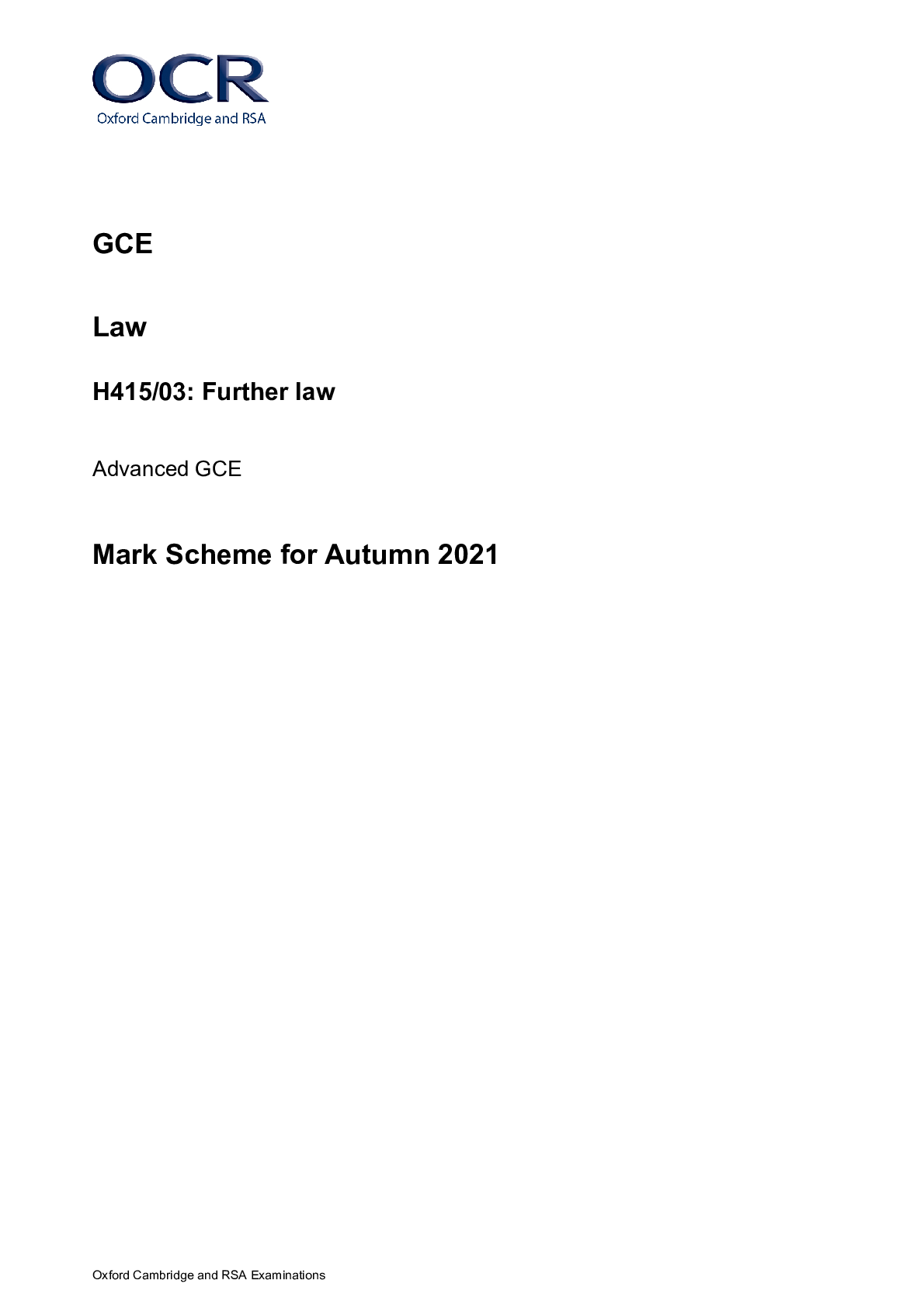
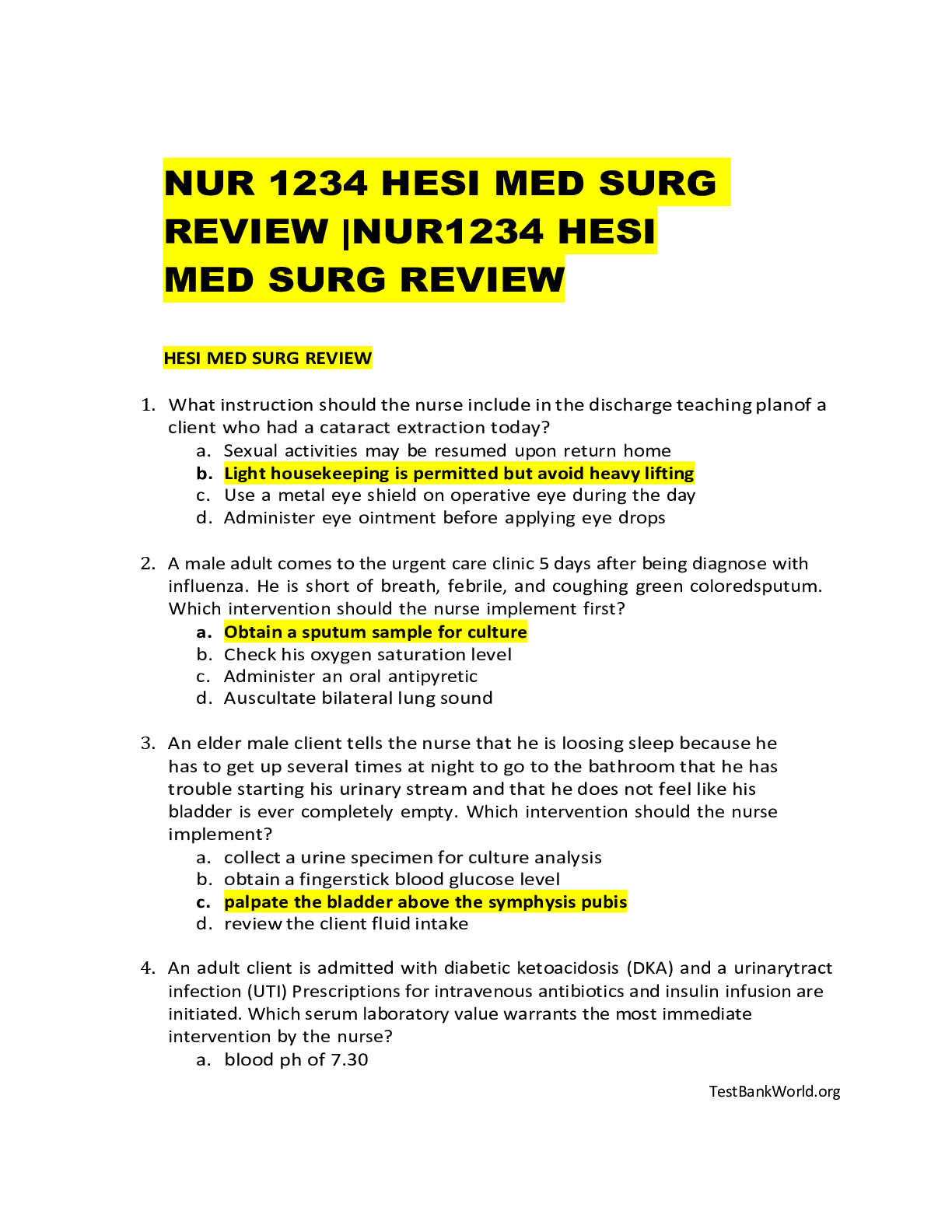
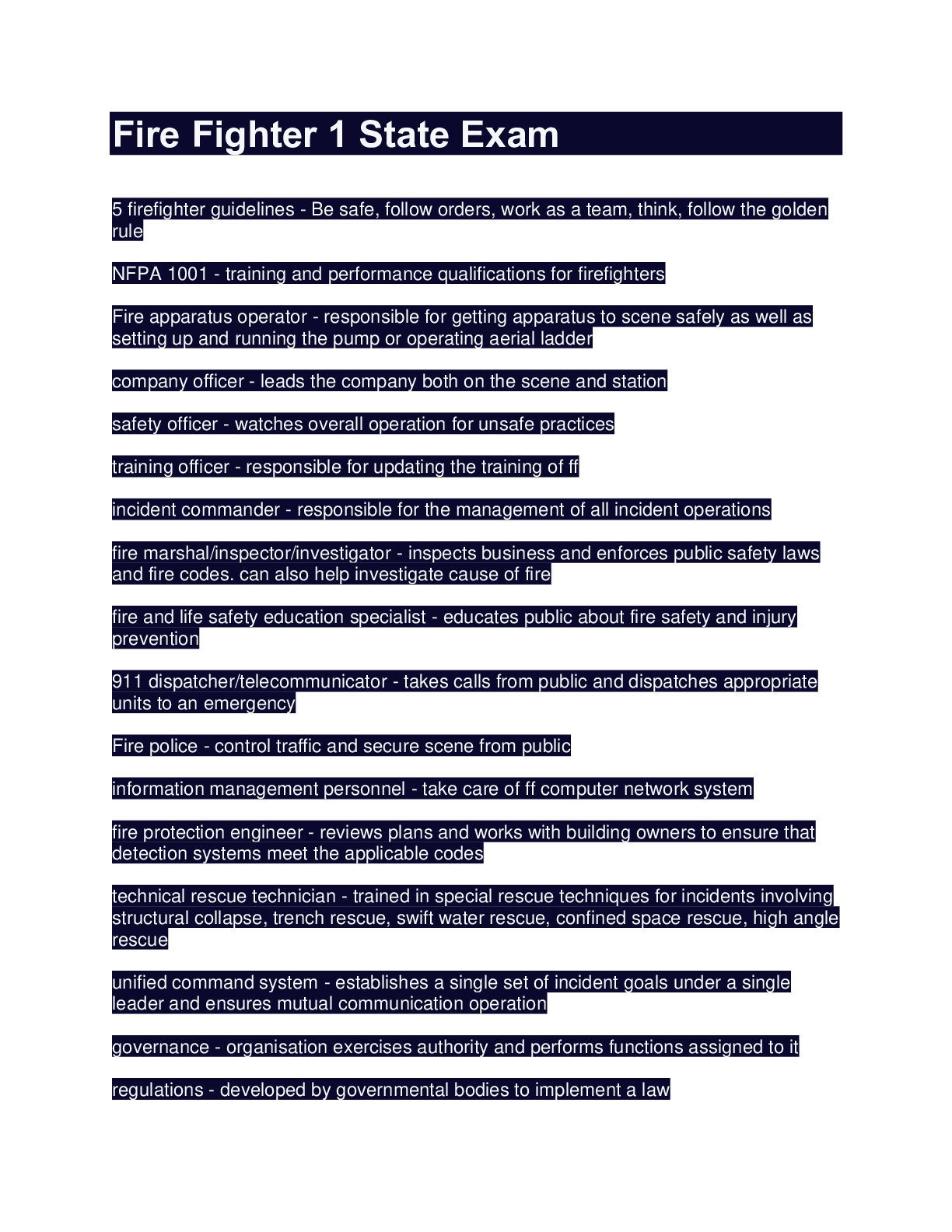

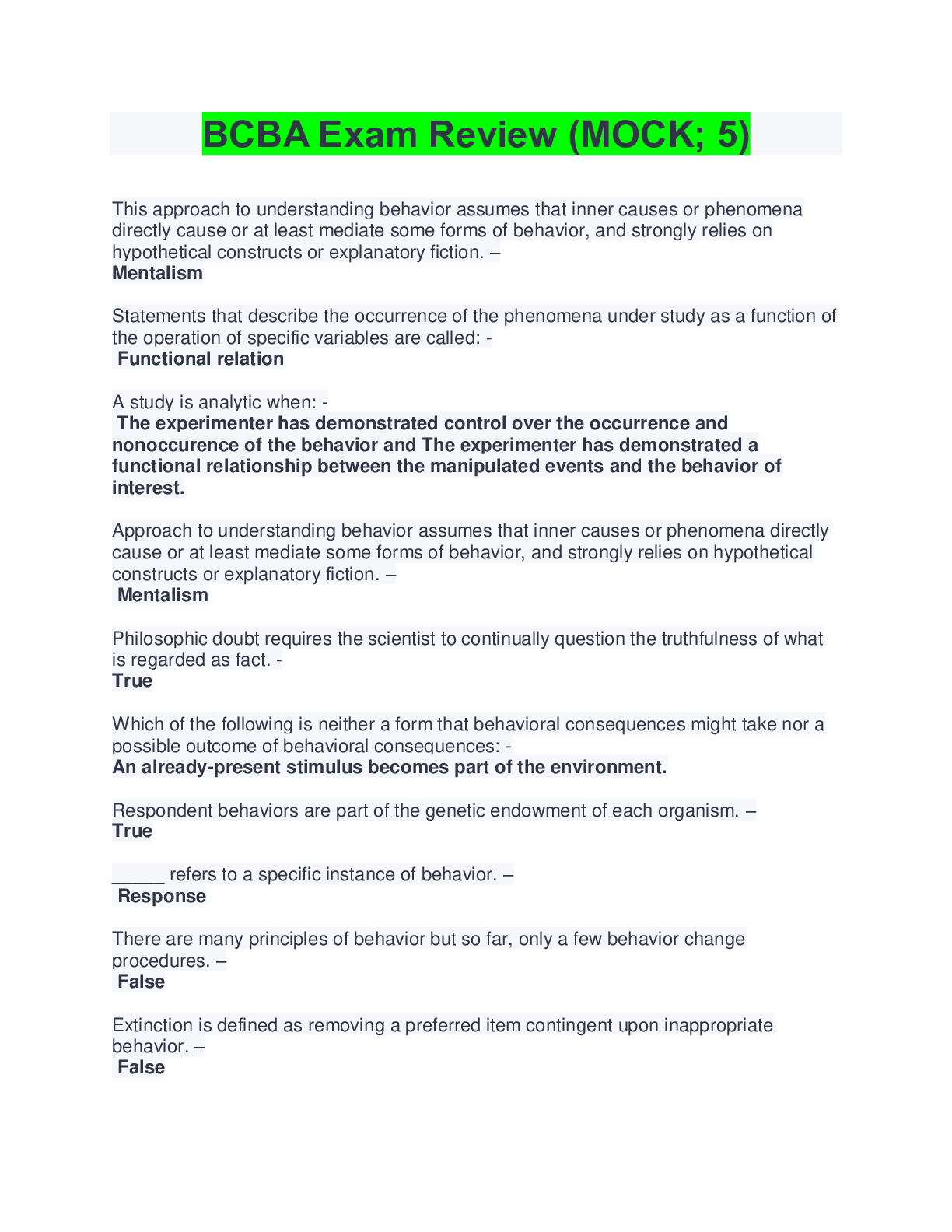
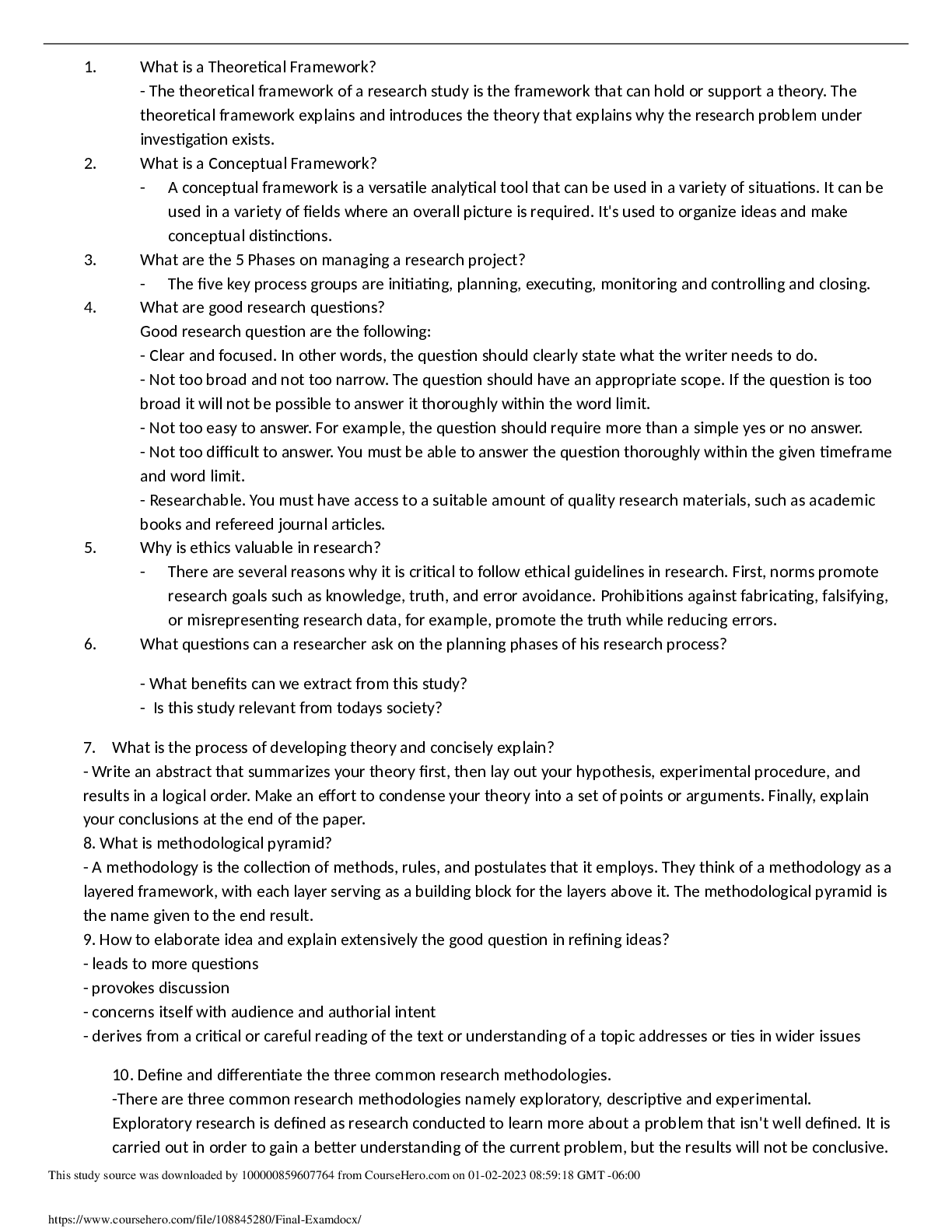

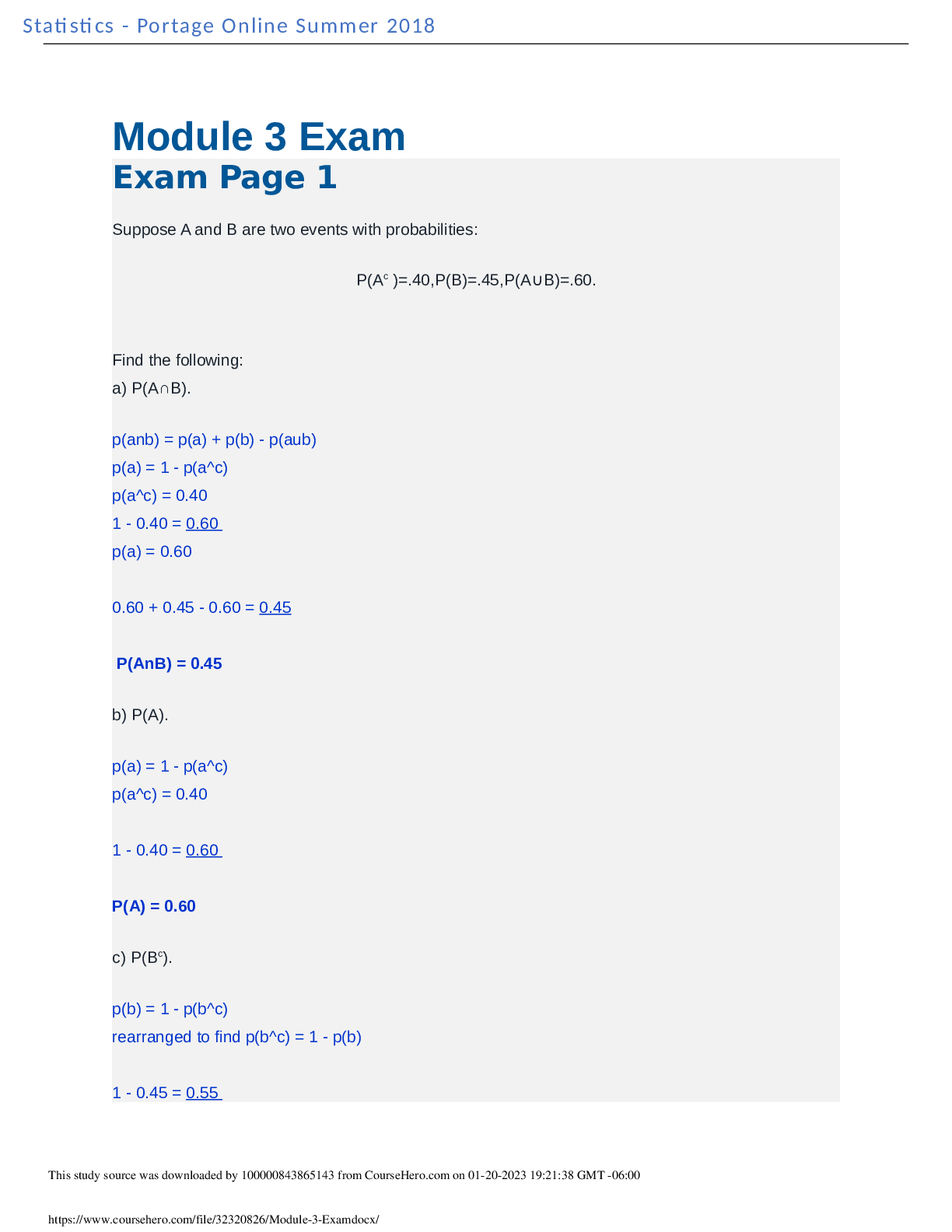
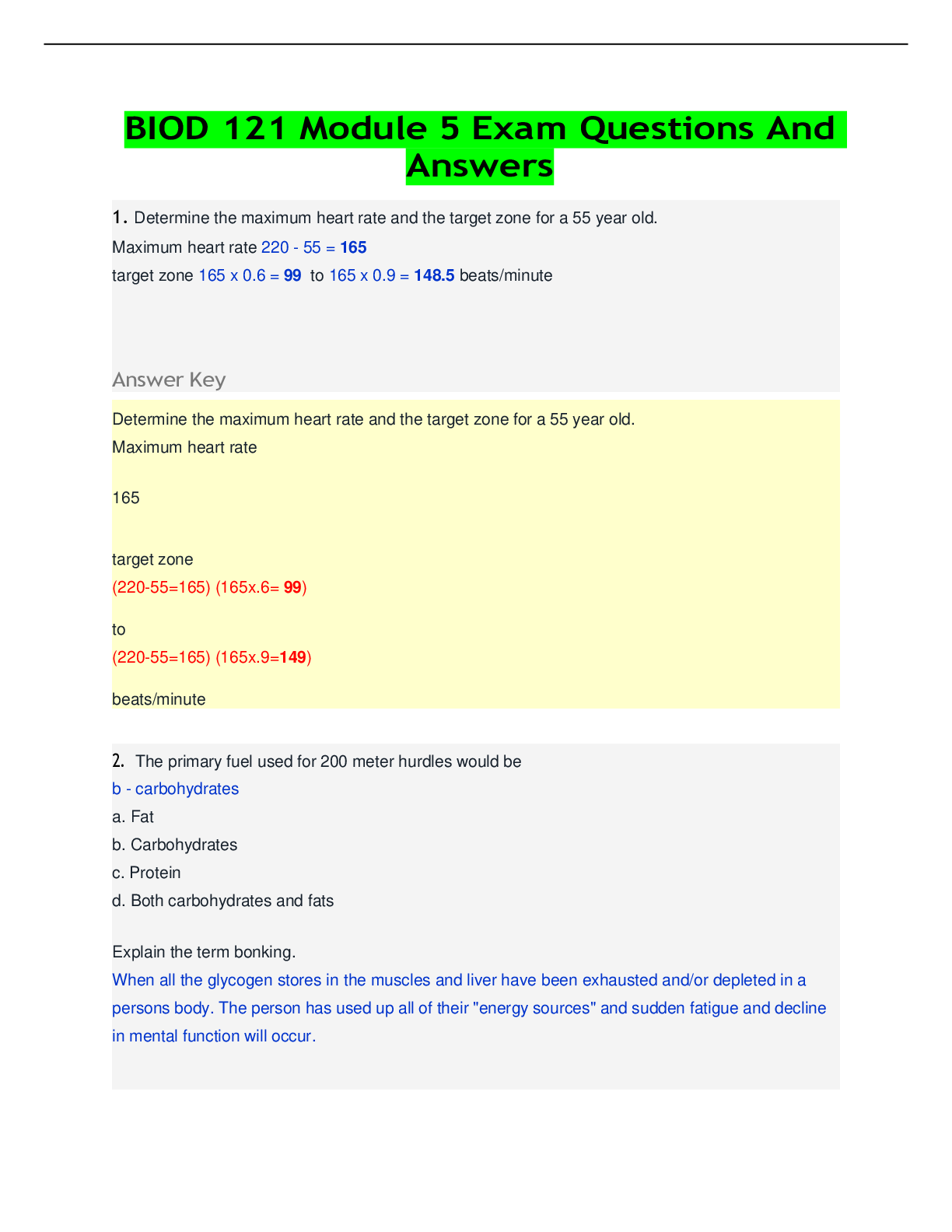

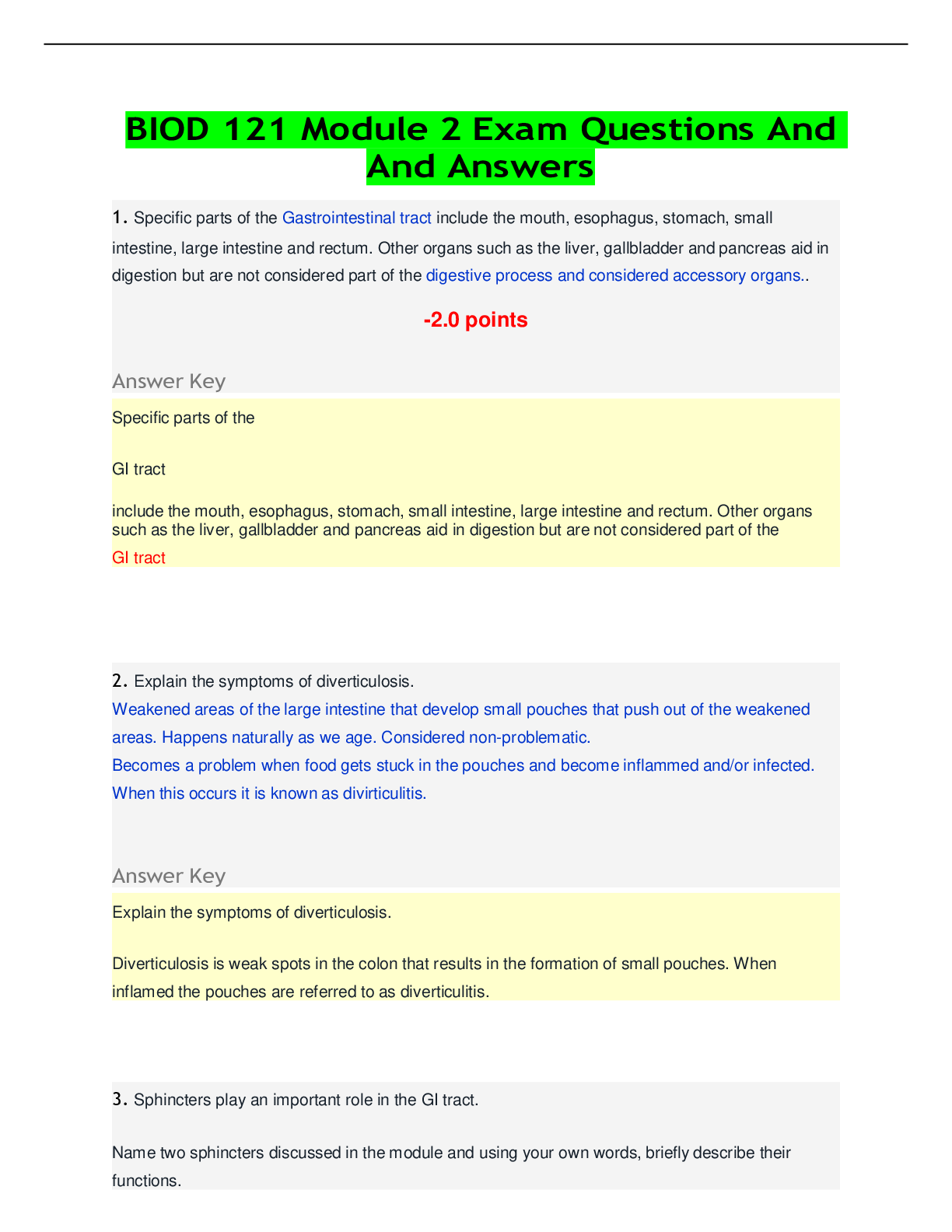

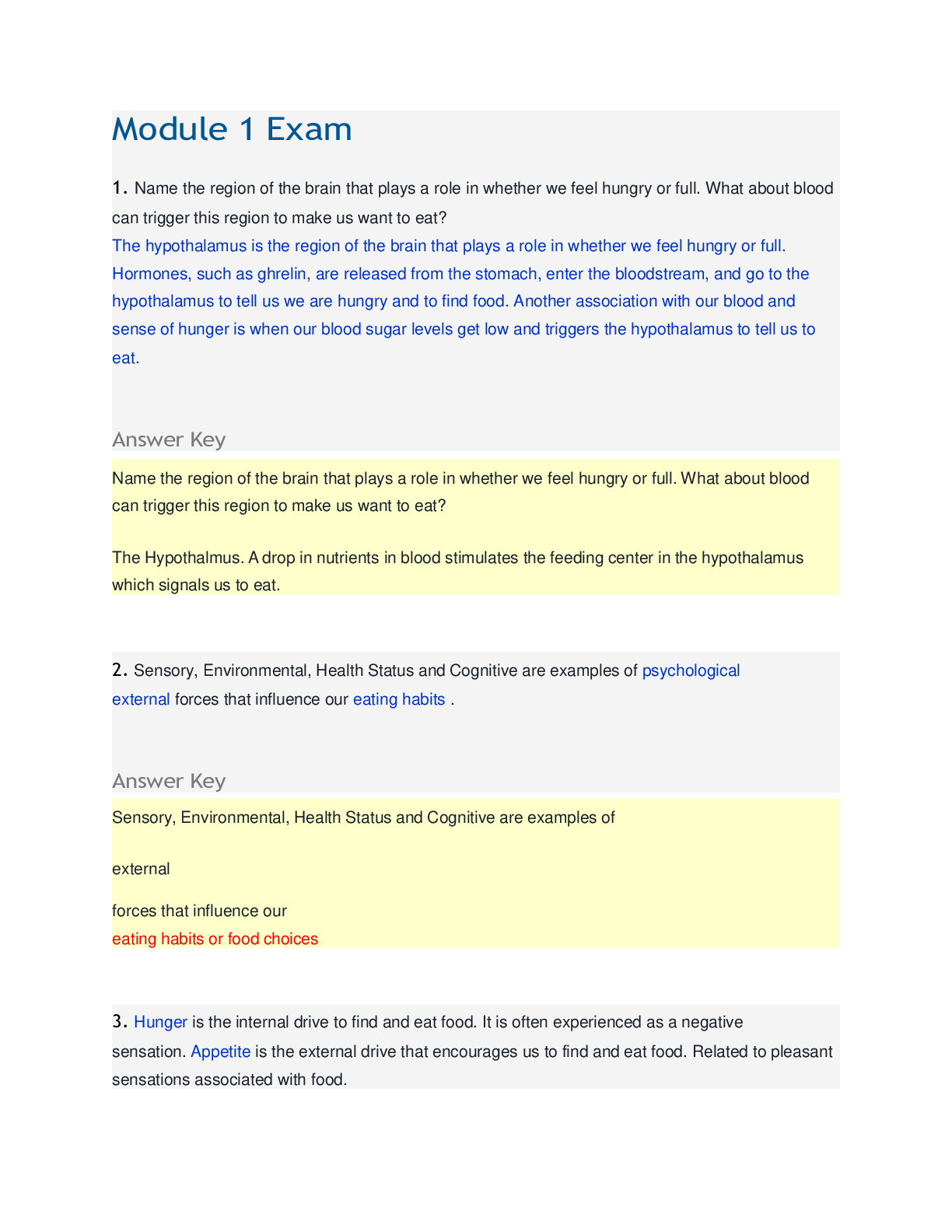
 (1).png)
 (1).png)
 (1).png)
